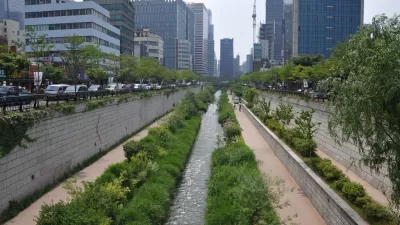The death toll from the torrential rains in Chennai, capital of Tamil Nadu state, and the surrounding region has climbed to 345 as of Dec. 4. While the scope of the rains are unprecedented, poor urban planning has been linked to the devastation.
"India's fourth-largest city, Chennai has boomed in the 21st century as a center for vehicle factories and IT outsourcing," writes Sanjeev Miglani for Reuters. "But trash-filled drains and building on lake beds in the rush to industrialization and prosperity has made it more prone to flooding."
"The floods have displaced about 1 million people in the Chennai area," according to a local reporter, writes Parth M.N. for the Los Angeles Times. Neglect of water storage may have contributed to the devastation.
(E)xperts believe poor city planning has magnified the devastation caused by a natural disaster. Many have gone a step further and called it a man-made disaster.
The head of Indian Meteorological Department, Laxman Singh Rathore, said (Dec. 2) that the flooding occurs because there is not enough space for the water to drain out, catchnews.com reported. In recent years, Chennai’s network of lakes, rivers, canals, wetlands and marshlands that previously absorbed rainwater or diverted it to the sea have been replaced by housing, malls, universities and businesses.
Chenai did not learn from Mumbai floods.
"Chennai has destroyed its water bodies the same way Mumbai had. Now Mumbai's disaster from a decade ago is repeating in Chennai," Himanshu Thakkar of the South Asian Network for Dams, Rivers, and People said, referring to the 2005 deluge in India’s booming financial capital, which left more than 1,000 people dead.
Sourjya Bhowmick writes in Catch that "mindless urbanisation, not rainfall, is behind Chennai floods."
At the start of the 20th century, Chennai had about 150 water bodies, big and small, around the city. Presently, only about 27 water bodies exist.
As the effects of climate change intensify, managing solid waste, improving drainage and afforestation need to be prioritised.
Nihar Gokhale, also of Catch, writes what can be done to prevent future floods. He points directly to urban planners in one solution: "Protect natural drainage systems."
India's urban planners often don't take water into account. In fact, water systems are blatantly destroyed.
In Chennai, for example, the local train network was expanded by erecting elevated tracks on the 25-metre wide Buckingham canal. This cut the canal's width to 10 metres and, thereby, greatly diminished its capacity to carry water into the Bay of Bengal.
"Clearly, indiscriminate development and shoddy urban planning have led to the floods in India's fourth most populous city," concludes Nityanand Jayaraman, a Chennai-based writer and social activist in his piece for the BBC News.
FULL STORY: Death toll climbs to 269 from torrential rain and flooding in southern India

Alabama: Trump Terminates Settlements for Black Communities Harmed By Raw Sewage
Trump deemed the landmark civil rights agreement “illegal DEI and environmental justice policy.”

Planetizen Federal Action Tracker
A weekly monitor of how Trump’s orders and actions are impacting planners and planning in America.

The 120 Year Old Tiny Home Villages That Sheltered San Francisco’s Earthquake Refugees
More than a century ago, San Francisco mobilized to house thousands of residents displaced by the 1906 earthquake. Could their strategy offer a model for the present?

In Both Crashes and Crime, Public Transportation is Far Safer than Driving
Contrary to popular assumptions, public transportation has far lower crash and crime rates than automobile travel. For safer communities, improve and encourage transit travel.

Report: Zoning Reforms Should Complement Nashville’s Ambitious Transit Plan
Without reform, restrictive zoning codes will limit the impact of the city’s planned transit expansion and could exclude some of the residents who depend on transit the most.

Judge Orders Release of Frozen IRA, IIJA Funding
The decision is a victory for environmental groups who charged that freezing funds for critical infrastructure and disaster response programs caused “real and irreparable harm” to communities.
Urban Design for Planners 1: Software Tools
This six-course series explores essential urban design concepts using open source software and equips planners with the tools they need to participate fully in the urban design process.
Planning for Universal Design
Learn the tools for implementing Universal Design in planning regulations.
Clanton & Associates, Inc.
Jessamine County Fiscal Court
Institute for Housing and Urban Development Studies (IHS)
City of Grandview
Harvard GSD Executive Education
Toledo-Lucas County Plan Commissions
Salt Lake City
NYU Wagner Graduate School of Public Service





























